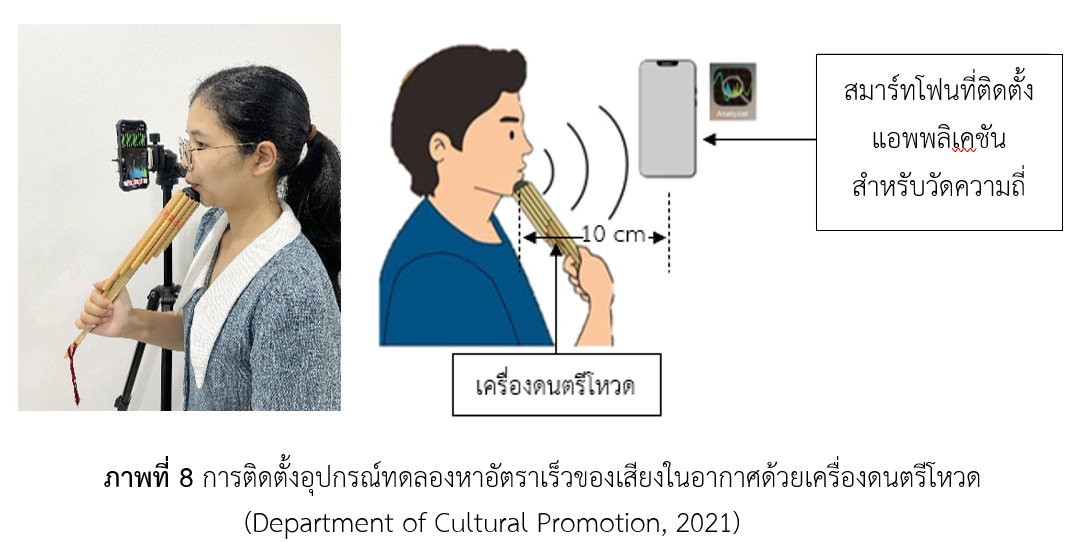การหาอัตราเร็วของเสียงในอากาศด้วยเครื่องดนตรีขลุ่ยและโหวดสำหรับผู้เรียนชั้นมัธยมศึกษาตอนปลาย
Main Article Content
บทคัดย่อ
การทดลองหาอัตราเร็วเสียงในอากาศเป็นการทดลองหนึ่งในวิชาฟิสิกส์ที่มีทั้งทฤษฎีและการคำนวณ การเรียนการสอนแบบทฤษฎีเพียงอย่างเดียวอาจทำให้ผู้เรียนไม่เข้าใจและเกิดความเบื่อหน่ายได้ หากปรับการสอนให้มีการนำอุปกรณ์สมัยใหม่ หรือเครื่องดนตรีมาใช้จะทำให้ผู้เรียนสนใจและสนุกกับการเรียนมากขึ้น ดังนั้นการวิจัยนี้จึงมีวัตถุประสงค์เพื่อสร้างชุดการทดลองหาอัตราเร็วของเสียงในอากาศจากขลุ่ยและโหวด และใช้สมาร์ทโฟนวัดความถี่เสียงที่ออกมาตามตัวโน๊ตที่เป่า ขลุ่ยจะเป็นตัวอย่างของการสั่นพ้องในท่อปลายเปิดและโหวดจะเป็นตัวอย่างของการสั่นพ้องในท่อปลายปิด ในการทดลองความสัมพันธ์ระหว่างความยาวของท่อสั่นพ้อง (L) กับความถี่เสียง (f) จะนำไปใช้ในการสร้างกราฟและคำนวณหาอัตราเร็วของเสียงในอากาศ ในการวิเคราะห์จะนำค่าอัตราเร็วของเสียงในอากาศที่ได้จากการทดลองมาเปรียบเทียบกับค่าที่ได้จากทางทฤษฎี ผลการทดลองพบว่าอัตราเร็วเสียงในอากาศจากเครื่องดนตรีขลุ่ยและโหวด มีค่าเท่ากับ 345.38 m/s และ 348.03 m/s ตามลำดับ เมื่อนำค่าที่ได้ไปเปรียบเทียบกับค่าอัตราเร็วของเสียงตามทฤษฎี ซึ่งเท่ากับ 347.26 m/s จะพบว่ามีความคลาดเคลื่อนร้อยละ 0.54 และ 0.22 ตามลำดับ นั่นแสดงว่าขลุ่ยและโหวดสามารถนำมาประยุกต์ใช้สำหรับการเรียนการสอนในระดับมัธยมศึกษาตอนปลายได้
Article Details

อนุญาตภายใต้เงื่อนไข Creative Commons Attribution-NonCommercial-NoDerivatives 4.0 International License.
วารสารวิทยาศาสตร์และวิทยาศาสตร์ศึกษา (JSSE) เป็นผู้ถือลิสิทธิ์บทความทุกบทความที่เผยแพร่ใน JSSE นี้ ทั้งนี้ ผู้เขียนจะต้องส่งแบบโอนลิขสิทธิ์บทความฉบับที่มีรายมือชื่อของผู้เขียนหลักหรือผู้ที่ได้รับมอบอำนาจแทนผู้เขียนทุกนให้กับ JSSE ก่อนที่บทความจะมีการเผยแพร่ผ่านเว็บไซต์ของวารสาร
แบบโอนลิขสิทธิ์บทความ (Copyright Transfer Form)
ทางวารสาร JSSE ได้กำหนดให้มีการกรอกแบบโอนลิขสิทธิ์บทความให้ครบถ้วนและส่งมายังกองบรรณาธิการในข้อมูลเสริม (supplementary data) พร้อมกับนิพนธ์ต้นฉบับ (manuscript) ที่ส่งมาขอรับการตีพิมพ์ ทั้งนี้ ผู้เขียนหลัก (corresponding authors) หรือผู้รับมอบอำนาจ (ในฐานะตัวแทนของผู้เขียนทุกคน) สามารถดำเนินการโอนลิขสิทธิ์บทความแทนผู้เขียนทั้งหมดได้ ซึ่งสามารถอัพโหลดไฟล์บทความต้นฉบับ (Manuscript) และไฟล์แบบโอนลิขสิทธิ์บทความ (Copyright Transfer Form) ในเมนู “Upload Submission” ดังนี้
1. อัพโหลดไฟล์บทความต้นฉบับ (Manuscript) ในเมนูย่อย Article Component > Article Text
2. อัพโหลดไฟล์แบบโอนลิขสิทธิ์บทความ (Copyright Transfer Form) ในเมนูย่อย Article Component > Other
ดาวน์โหลด ไฟล์แบบโอนลิขสิทธิ์บทความ (Copyright Transfer Form)
เอกสารอ้างอิง
Boonsatta, N. (2014). Thai music (flute) (in Thai). Retrieved 15 December 2023, from Blogspot: http://boonsatta.blogspot.com
Bodinchart, S. (2012). Physics 1. Pathum Thani: Sky books.
Datkamjon, N. (2022). Learning Management of Khlui Peang-Or Flute Skill through Brain-Based Learning and QR Code for Mathayomsuksa 2 Students. Master of Education Program, Uttaradit: Uttaradit Rajabhat University.
Department of Cultural Promotion. (2021). How to play vote (in Thai). Retrieved 15 December 2023, from Facebook: https://www.facebook.com/watch/?v=227187312620049
Lopresto, M. C. (2011). Experimenting with end-correction and the speed of sound. Physics education, 46(4), 437.
Niran, S. (2017). Handbook of learning Physics M.5 volume 4. Nonthaburi: Phoemsap Printing.
Office of the Basic Education Commission. (2017). Basic Education Core Curriculum B.E. 2560 (in Thai). Bangkok: Agricultural cooperative printing demonstrations of Thai.
Parameth, P. (2016). Physic 1. Bangkok: Sripathum University.
Petudom, S. (2017). The development skill of Khluy-Peang-Or (in Thai). Retrieved 12 December 2023, from NakhonsawanSchool: https://km.nssc.ac.th/external_newsblog.php?links=1637
Phathong, D., Chan-on, A. and Danpradit, P. (2017). The selection-Purchase of Wot and Kaen: A case study Bang Tha Ruea, Nakhon Phanom (in Thai). Music and Performing Art Journal, 3(1), 34-48.
Phonkhate, Y. (2019). Knowledge of vote (in Thai). Retrieved 20 November 2023, from Google site: https://sites.google.com/site/karphathnabthreiynbnweb2529/howd.
Tiwaree, R., Cheumklang, K., Phromyod, N. and Songpongs, P. (2018). Guide to Conducting Sound Experiment Activities via Smartphone or Tablet Apps and PC (in Thai). Bangkok: The Institute for the Promotion of Teaching Science and Technology.
Torcal-Milla, F. J. (2023). Measuring the speed of sound with a pan flute and a smartphone: a half-melodicand totally-didactic experiment. Physics Education, 58(5), 055010.


